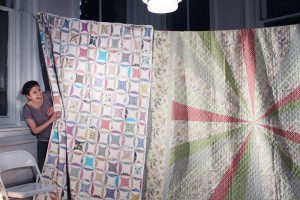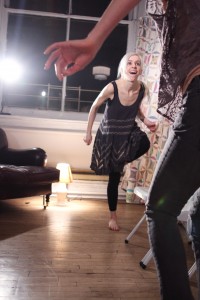It is very difficult for a critic to express one’s full appreciation of a performance without addressing the complexities of the experience. Even if a show does not satisfy, a production requires so much labor from a diversity of voices that define the theatrical event that it would be unfair for a critic to raze over a work without acknowledging the moments of brilliance. The Deer Players’ production of The Brink of Us is not a successful play, yet some elements make it a unique work.
The play opens with a short prologue delivered by the character of Elliot, played by Tom Kelsey, explaining his close relationship with his sister. He is very emphatic about how they shared certain experiences that others would not have understood. Many years later, after his sister committed suicide, Elliot has invited his group of friends to spend a weekend at his cabin in the woods. Yet as they drink and consume every drug with which they experimented in their youth, civility starts peeling away and the audience discovers Elliot’s real motive for inviting them over: he believes that one of them killed his sister.
The people at the cabin are basically divided into four couples. There is the egotistical Alex, played by Julia Piker, a published writer who does not worry about revealing the most embarrassing secrets about herself. She arrives together with Max, played by Zachary J. Smith, who seems to faithfully follow all of Alex’s whims. Then there is Sean, played by Daniel Cuff, and Liz, played by Annelise Nielsen. They appear to be a very normal young couple, when in reality both are dealing with her nervous breakdown, whose ripples are still felt from time to time. After the audience is given a chance to meet the first two couples, Sebastian, played by Peter Staley, bursts in with an energetic indifference stereotypical of a young corporate lawyer. His girlfriend, Ellen, played by Linda Tardif, arrives separately already demonstrating that she will be the complete opposite of Sebastian. Finally, there is the host’s girlfriend, Sally, played by Starr Kirkland, a childish presence whose innocence shines among this group of apparently broken individuals.
The cast does a great job with what they are given, yet suffers from the script’s confusion in how it wants to tell its story. The playwright, Delaney Britt Brewer, takes the traditional yarn of older friends coming together and noticing how each one has changed, yet pushes it down a much darker path. This darkness involves death, revenge, the loss of innocence, betrayal, and coming to grips with an obscure past. Nevertheless, when the story initiates this much more interesting journey, the play becomes an almost farcical comedy. The combination of drama, comedy and horror is very difficult to achieve and I admire the bravery of the artists to do so, yet it bogs down a play that shows so much promise. The characters go from dealing with a seriously dark secret to enthusiastically eating a tablecloth due to extreme hunger. Later one comes out clownishly drenched in blood while another one gives a sweet rendition of Don Henley’s “The Boys of Summer” in the middle of the play’s most chaotic build-up. Kara-Lynn Vaeni’s direction does not add cohesion to these moments and so the audience is lost in its midst. The whole world that is contained within Elliot’s cabin and which shows moments of Hitchcockian humor and gloom, sadly crumbles at the end. Yet there is enough flair in the turns taken by the story and in the way that it is acted to ultimately demonstrate the talent behind the work, even if it suffers from a loss of focus.
The Brink of Us is presented at South Oxford Space (138 South Oxford Street between Atlantic Avenue and Hanson Place in Brooklyn) through May 17. Performances are Fridays through Sundays at 8 p.m. with an extra performance on Thursday, May 15 at 8 p.m. Tickets are $20 for the general public and $18 for students. These can be purchased online at http://brinkofus.brownpapertickets.com or by calling 1-800-836-3006.


















